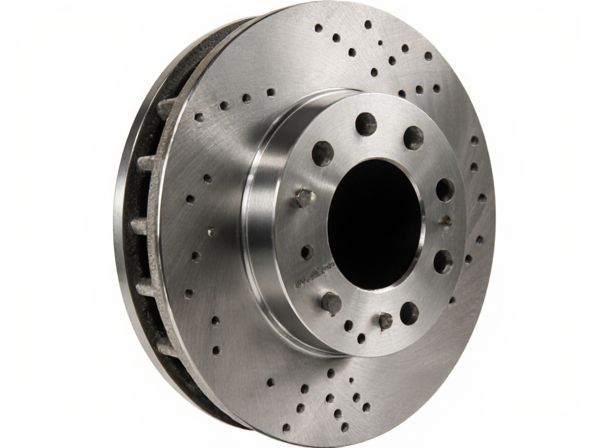
Photo illustration: Vented Rotors vs Solid Rotors
Vented rotors provide improved heat dissipation due to their internal vanes, reducing the risk of brake fade during intense driving conditions. Solid rotors, being a single mass of metal, are typically more durable and less expensive but may overheat more quickly under heavy use. Choosing the right rotor depends on your driving style, vehicle type, and performance needs.
Table of Comparison
| Feature | Vented Rotors | Solid Rotors |
|---|---|---|
| Design | Two plates with air vents between | Single solid metal plate |
| Heat Dissipation | Excellent due to airflow channels | Limited heat dissipation |
| Performance | Better for heavy braking and high speeds | Best for normal driving conditions |
| Durability | Longer lifespan under stress | Can warp under high heat |
| Cost | More expensive | Less expensive |
| Weight | Heavier due to design | Lighter |
| Ideal Use | Performance cars, towing, aggressive braking | Daily commute, light vehicles |
Introduction to Brake Rotors
Brake rotors serve as the critical component in disc brake systems, converting kinetic energy into heat through friction to slow or stop a vehicle. Vented rotors feature internal channels that enhance heat dissipation, reducing brake fade during intense or prolonged braking. Solid rotors, in contrast, are a single solid piece, offering durability and cost-effectiveness for standard driving conditions but less efficient heat management.
What Are Vented Rotors?
Vented rotors are brake discs designed with internal vanes or channels that allow air to flow through, enhancing heat dissipation during braking. This ventilation reduces the risk of brake fade and helps maintain consistent braking performance under high-stress conditions. Commonly used in performance vehicles and heavy-duty trucks, vented rotors improve safety and longevity compared to solid rotors.
What Are Solid Rotors?
Solid rotors are a type of brake rotor commonly used in vehicles, characterized by a single, solid piece of metal without internal ventilation channels. They provide consistent braking performance, especially in low to moderate heat conditions, making them ideal for everyday driving and lighter vehicles. Solid rotors typically cost less and are easier to manufacture compared to vented rotors, but they dissipate heat less efficiently, which can lead to increased brake fade during heavy or prolonged braking.
Heat Dissipation: Vented vs Solid Rotors
Vented rotors feature internal vanes that promote airflow, significantly improving heat dissipation compared to solid rotors. Enhanced cooling reduces the risk of brake fade and maintains consistent braking performance during extended use. Solid rotors, with their compact design, retain more heat, making them less effective for high-performance or heavy-duty applications.
Performance in Different Driving Conditions
Vented rotors enhance braking performance by dissipating heat more efficiently, making them ideal for high-performance driving, steep descents, and towing where repeated braking generates significant heat. Solid rotors perform well under normal driving conditions with lighter braking demands but may experience faster fade during prolonged or aggressive braking due to less effective heat dissipation. Choosing vented rotors improves safety and consistency in performance during intense or continuous braking scenarios, while solid rotors are sufficient for everyday, low-stress driving environments.
Durability and Longevity Comparison
Vented rotors offer enhanced durability and longevity by dissipating heat more effectively, reducing the risk of warping and brake fade during prolonged or heavy braking. Solid rotors, while typically more affordable, tend to retain heat longer, which can lead to faster wear and decreased lifespan under high-stress conditions. Choosing vented rotors improves overall brake system performance and extends the service interval, especially in demanding driving environments.
Maintenance and Replacement Costs
Vented rotors typically require more frequent maintenance due to their complex design, which helps dissipate heat but can accumulate debris and wear faster, leading to higher replacement costs. Solid rotors, with their simpler construction, generally incur lower maintenance expenses and cost less to replace, making them a more economical option for everyday driving. Selecting between vented and solid rotors depends on balancing performance needs with long-term maintenance and replacement budgets.
Ideal Applications for Vented Rotors
Vented rotors are ideal for high-performance vehicles and heavy-duty applications where efficient heat dissipation is crucial to prevent brake fade and maintain consistent braking performance. Their design features internal channels that allow air to flow through, making them suitable for racing cars, trucks, and SUVs frequently subjected to heavy braking and towing. These rotors excel in environments that demand rapid cooling and durability under high thermal stress.
Ideal Applications for Solid Rotors
Solid rotors are ideal for light-duty vehicles and everyday urban driving where braking demands are moderate and heat dissipation is less critical. They excel in applications such as compact cars and motorcycles that benefit from their simpler design and lower manufacturing cost. Solid rotors provide reliable performance in environments with minimal exposure to intense braking or high-speed conditions.
Choosing the Right Rotor for Your Vehicle
Choosing the right rotor for your vehicle depends on your driving style and performance needs; vented rotors offer superior heat dissipation ideal for heavy-duty or high-performance driving, reducing brake fade during prolonged use. Solid rotors, being simpler and typically less expensive, are suitable for everyday driving with lighter braking demands, providing reliable stopping power without the complexity of vented designs. Evaluate factors such as vehicle weight, driving conditions, and brake system compatibility to ensure optimal safety and performance.
 caratoz.com
caratoz.com